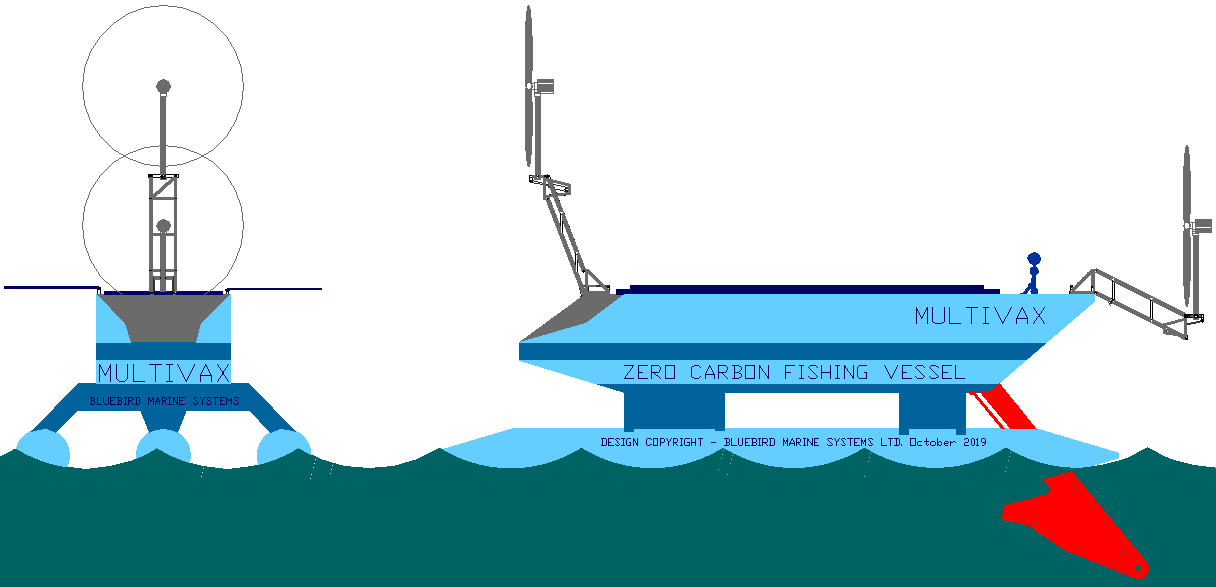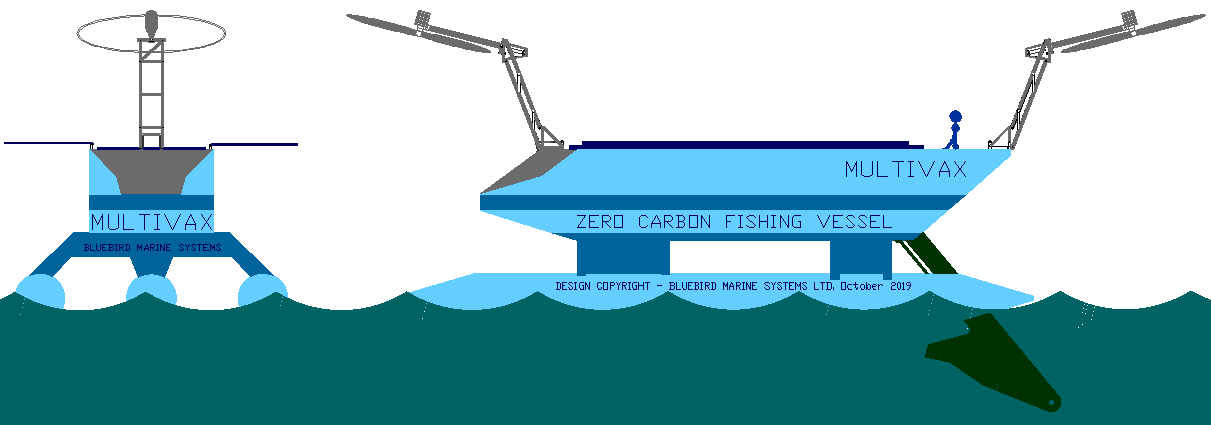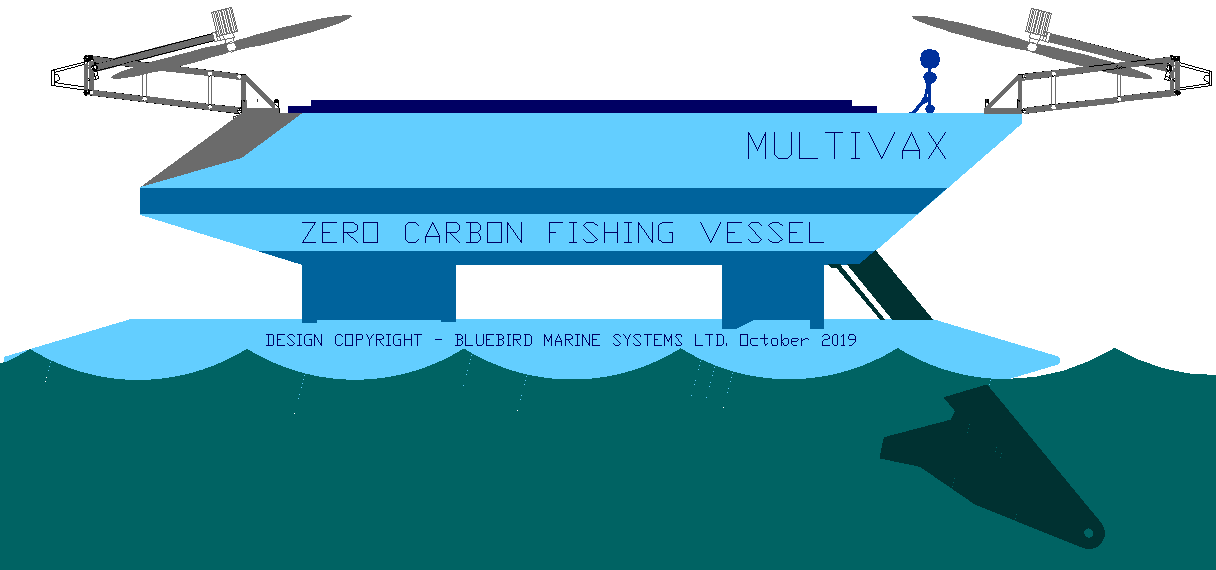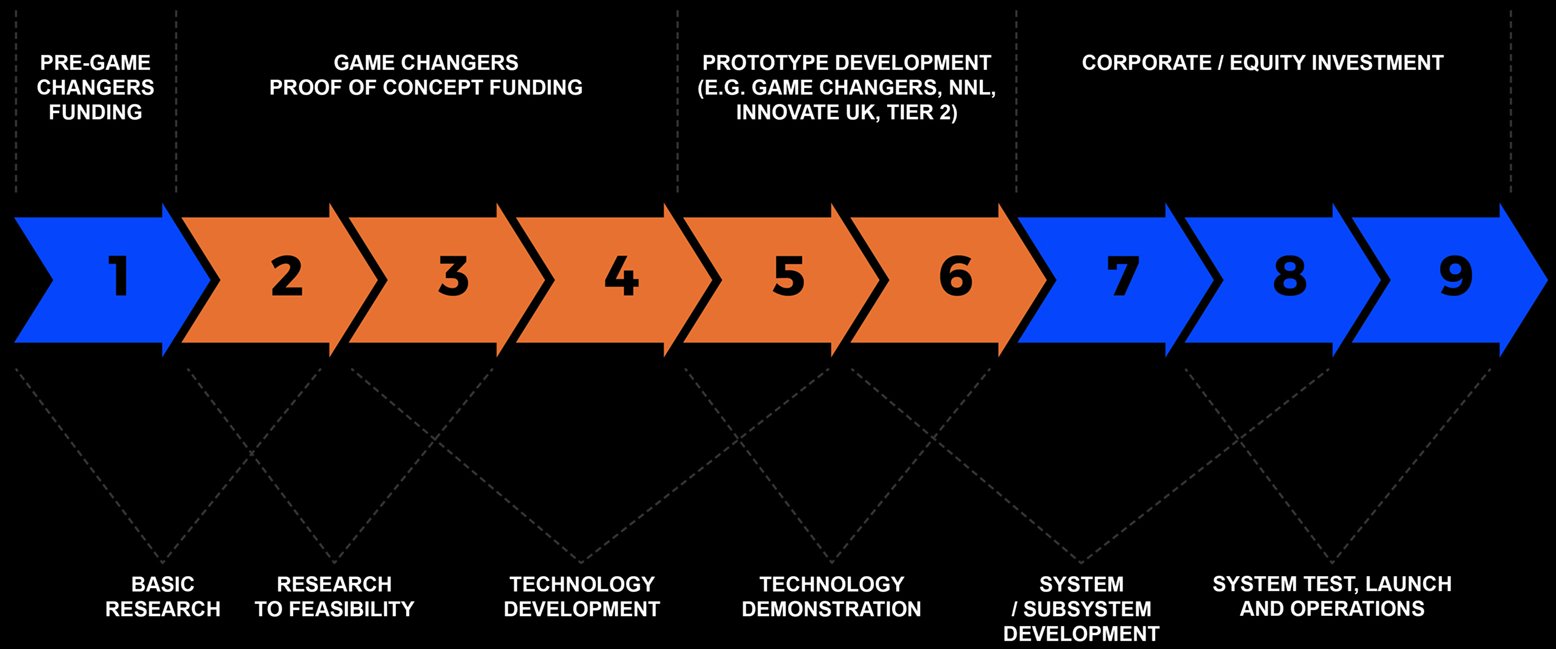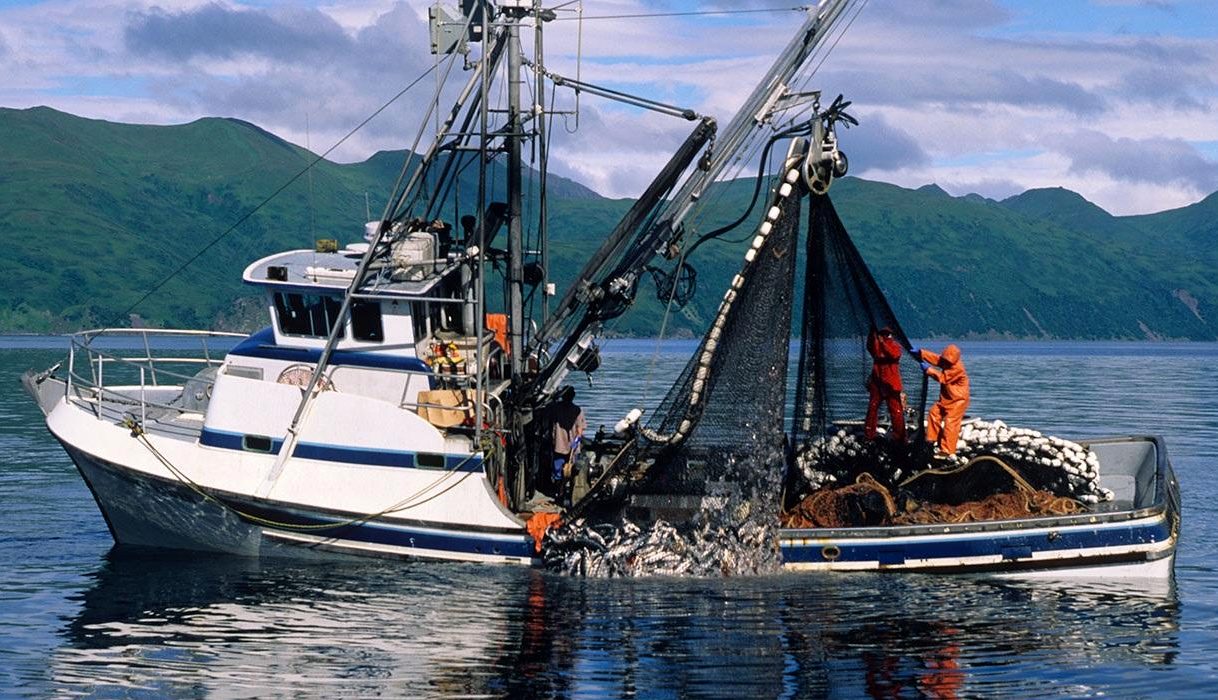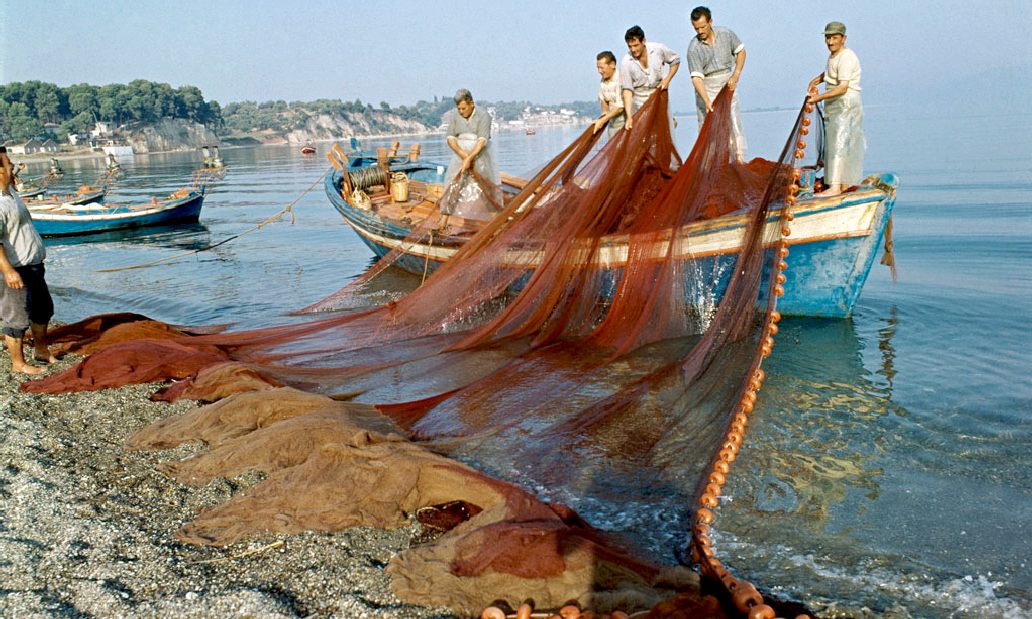|
MULTIVAX Please use our A-Z INDEX to navigate this site where page links may lead to external sites ABOUT - CIRCUMNAVIGATION - CLIMATE CHANGE A-Z - CONTACTS - DONATE - FOUNDATION - OCEAN PLASTIC A-Z - HOME
TURBINES RAISED - In this picture the 'MultiVax' is seen with her wind generators raised at different heights to harvest energy for propulsion and fishing operations. The fishing head is shown in red, deployed to fish for sardines, mackerel or herring. The head can be raised and lowered to different depths as the onboard sensors locate the fish. Copyright © diagrams October 24 2019. All rights reserved, Cleaner Ocean Foundation Ltd and Bluebird Marine Systems Ltd.
The world is facing food insecurity brought on by accumulated waste, the by-product of modern living. Modern fishing boats use fossil fuels to fish, not only polluting the atmosphere with particulates, but also adding to global warming and acid oceans.
Traditional fishing boats do not lend themselves to solar or wind assisted conversions because they don't use electric motors, they burn diesel. Working out how to use renewable energy requires a clean sheet of paper approach and a re-think of how to solve the problem.
The SeaVax concept has long been seen as capable of being modified for fishing for food, rather than recycling marine plastic. If shipping is to comply with the International Maritime Organization's (IMO) directives for 2030 (40%), 2040 (45%), 2050 (50%) and 2100 (100%), we must start looking at other ways of harvesting fish to prevent global warming getting any worse.
Bluebird Marine Systems proposed a zero emissions project for MarRI backing that could be developed (tuned) for zero carbon fishing by way of securing food for a growing population.
From 2020 we will keep our eyes open for funding calls that may see us qualify for grants. But don't hold your breath, typically grants are not given to small enterprises without a substantial trading track record. This normally means that funding applications are a waste of limited resources, hence we might not apply where the risk is too great - for example if the call is not 100% on point. Time is after all money! But time is one thing we do not have in the race to halt climate change - and money is only a tool to make things happen. It follows that to make things happen, money should be made available without the Red-Tape so beloved by policy makers: if we are to meet zero carbon objectives.
The above chart is where to start for fishing using more efficient species selective filtration, in the process doing away with nets.
A bonus is that with selective fishing, bycatch is reduced coupled with the possibility of eliminating or reducing the need for plastic nets, so that the ghost nets that make up more then 45% of the great pacific garbage patch might be significantly reduced.
FURLED HIGH - The wind turbines are parked at a high level. They can be furled lower down in rough conditions by lowering the masts. When stored in this position the turbine blades do not revolve and can be locked. The fishing head is shown in green in this picture.
FURLED LOW - The wind turbines are parked at a low level at the bow and stern. They can be configured to fold over the hull, instead of out to se. When stored in this position the turbine blades present little area to the wind.
FURLED FOR HARBOURS - For docking and longer term parking the windgens might be folded as per the diagram above. Copyright © diagrams October 24 2019. All rights reserved, Cleaner Ocean Foundation Ltd and Bluebird Marine Systems Ltd.
ECONOMICS & OPPORTUNITY
Operating a zero carbon fishing boat that uses no nets in the catching process, opens up a whole new era of sustainable opportunities in terms of the United Nations development goal: SDG14.
Nets are costly items that choke the ocean when discarded irresponsibly. The possibility of modifying a SeaVax head to allow for variable depth trawl of selected fish species holds the potential to alleviate ghost nets to some extent, though fishing with regular nets would also be a feature of the design.
TRL 1 - TRL 2 - TRL 3 - TRL 4 - TRL 5 - TRL 6 - TRL 7 - TRL 8 - TRL 9 - TRL 10
TRL SCALE - The TRL scale is a metric for describing the maturity of a technology. The acronym stands for Technology Readiness Level. The scale consists of 9 levels. Each level characterises the progress in the development of a technology, from the idea (level 1) to the full deployment of the product in the marketplace after level 9. MultiVax is at TRL 1.
REPORT
5 FEBRUARY 2016 (Science Mag) - CLEANER FUELS FOR FISHING
BOATS COULD BACKFIRE ON THE CLIMATE
BLACK CARBON - Fishing vessels were recently found to be the largest source of black carbon ship emissions in the Arctic, suggesting that the fishing sector should be a focus for future studies. Here we developed a global and Arctic emissions inventory for fishing vessel emissions of short lived and long lived climate forcers based on data from a wide range of vessel sizes, fuel sulfur contents, engine types, and operational characteristics. We found that previous work generally underestimated emissions of short lived climate forcers due to a failure to account for small fishing vessels as well as variability in emission factors. In particular, global black carbon emissions were underestimated by an order of magnitude. Furthermore, our order of magnitude estimate of the net climate effect from these fishing vessel emissions suggests that short lived climate forcing may be particularly important in regions where fuel has a low sulfur content. These results have implications for proposed maritime policies and provide a foundation for future climate simulations to forecast climate change impacts in the Arctic.
Black
carbon warms the atmosphere because of its ability to absorb
radiation from the
sun, but its effect can be especially pernicious in polar
regions, where, falling on bright ice, the soot diminishes the
regions’ ability to reflect away heat. For now, however, in
many parts of the world, Campbell and McKuin found that the warming
effect of the black carbon is counteracted by the cooling
effect of sulfur pollution.
When burned, the sulfur-heavy fuels often used by fishing
boats emit sulfur oxides, which are converted in the
atmosphere into sulfate particles. These shiny aerosols
reflect sunlight back to space,
leaving Earth
cooler. They also can seed the formation of clouds, which also
reflect light.
GHOST NETS - A sea turtle is ensnared in this fishing net that has been abandoned by fishermen. Fishing nets are made of plastic that is very tough and float around killing marine wildlife and when they finally sink, cause more harm to ocean ecosystems. Ghost nets are fishing nets that have been left or lost in the ocean by fishermen. These nets, often nearly invisible in the dim light, can be left tangled on a rocky reef or drifting in the open sea. They can entangle fish, dolphins, sea turtles, sharks, dugongs, crocodiles, seabirds, crabs, and other creatures, including the occasional human diver. Acting as designed, the nets restrict movement, causing starvation, laceration an
One
take-home message for consumers is that, just as milk
doesn’t come from a carton, fish don’t come from a can.
“People don’t realize how much time boats are spending
trawling around,” says Jennifer Burney, an environmental
scientist at UC San Diego who was not a party to the study,
and she’s not surprised to see the high climate costs of crustaceans
and large pelagic species. Yet overall, she says, emissions
from fishing pale in comparison to industries on land, such as
power generation from coal
plants.
TRADITIONAL FISHING BOATS - According to a report published in January 2016, the average engine power of commercial fishing vessels is 701kW for the main engine and 55kW for the auxiliary engine [ICF International, 2009]. The average size of decked fishing vessels is 20GT (around 10–15m). Only a small fraction of vessels, 1% of the global fishing fleet, are larger than 100GT (or longer than 24m) (FAO, 2005, Fisheries and Aquaculture topics, Fishing vessels:
http://www.fao.org/fishery/topic/1616/en
Globally, 88% of the installed main engines of commercial fishing vessels operate MSD, and 12% operate high speed diesel (HSD) engines [Trozzi, 2010]. Marine distillate oil (MDO, also called marine gas oil or MGO) is the most commonly used fuel for fishing boats and other MSD engines [ICF Consulting, 1999]. However, a small fraction of fishing boats use heavy fuel oil (HFO) [Trozzi, 2010].
Anchovies | Bass | Bream | Catfish | Clams | Cod Coley | Crabs | Crayfish | Eels | Grouper | Haddock | Hake | Halibut | Herring | Jellyfish Krill | Lobster | Mackerel | Marlin | Monkfish | Mullet | Mussels | Oysters | Perch | Plaice | Pollock | Prawns | Rays | Sablefish | Salmon Sardines | Scallops | Sharks | Shrimp | Skate | Sole | Sprat | Squid | Sturgeon | Swordfish | Trout | Tuna | Turbot | Whiting
PROBLEM - From 2000 to 2012, the National Marine Fisheries Service reported an average of 11 large whales entangled in ghost nets every year along the US west coast. From 2002 to 2010, 870 nets were recovered in Washington (state) with over 32,000 marine animals trapped inside. Ghost gear is estimated to account for 10% of all marine litter.
Some commercial fisherman use gillnets that are suspended in the sea by flotation buoys, such as glass floats, along one edge. In this way they can form a vertical wall hundreds of metres long, where any fish within a certain size range can be caught. If not collected by fishermen these nets can continue to catch fish until the weight of the catch exceeds the buoyancy of the floats. The net then sinks, and the fish are devoured by bottom-dwelling crustaceans and other fish. Then the floats pull the net up again and the cycle continues. Given the high-quality synthetics that are used today, the destruction can continue for a long time.
LINKS & REFERENCE
https://
SUSTAINABLE FISHING: UN picture of fishermen in Evia, Greece, fishing using nets from small boats as they have for hundreds of years without destroying our fisheries. Marine capture fisheries are a critical component for food security. Their production is close to the maximum ecosystem productivity (NRC 2006), cannot be increased substantially in the future and could decline if not properly managed, leaving the world to solve a significant new food deficit.
This website is provided on a free basis as a public information service. Copyright © Cleaner Oceans Foundation Ltd (COFL) (Company No: 4674774) 2019. Solar Studios, BN271RF, United Kingdom. COFL is a charity without share capital. The names Amphimax™ RiverVax™ and SeaVax™ are trademarks.
|
